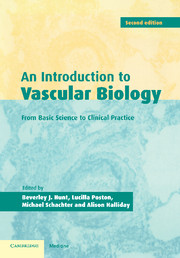Book contents
- Frontmatter
- Contents
- List of contributors
- Preface
- Part I Basic science
- 1 Vascular tone
- 2 Vascular compliance
- 3 Flow-mediated responses in the circulation
- 4 Neurohumoral regulation of vascular tone
- 5 Angiogenesis: basic concepts and the application of gene therapy
- 6 The regulation of vascular smooth muscle cell apoptosis
- 7 Wound healing: laboratory investigation and modulating agents
- Part II Pathophysiology: mechanisms and imaging
- Part III Clinical practice
- Index
3 - Flow-mediated responses in the circulation
Published online by Cambridge University Press: 07 September 2009
- Frontmatter
- Contents
- List of contributors
- Preface
- Part I Basic science
- 1 Vascular tone
- 2 Vascular compliance
- 3 Flow-mediated responses in the circulation
- 4 Neurohumoral regulation of vascular tone
- 5 Angiogenesis: basic concepts and the application of gene therapy
- 6 The regulation of vascular smooth muscle cell apoptosis
- 7 Wound healing: laboratory investigation and modulating agents
- Part II Pathophysiology: mechanisms and imaging
- Part III Clinical practice
- Index
Summary
Introduction
Haemodynamic forces are now well established as important modulators of vascular tone and vascular wall remodelling, and are increasingly implicated in atherogenesis. Blood vessels are under the influence of two primary haemodynamic forces: firstly, the circumferential force, the wall tension, which originates from the blood pressure and, secondly, the frictional force or shear stress which results from blood flow along the vessel wall. Although the circumferential force has important influences on vascular tone, it is the intention of this short review to concentrate upon flow-associated events in the vasculature. The shear stress experienced by the endothelium is a function of the ‘axial’ pressure gradient (Figure 3.1) which occurs as blood flows through the vessel (Malek and Izumo, 1994) and, physiologically, is of the order of 0–50 dyn/cm2 (Figure 3.2).
Until recently, little was known of the mechanisms whereby the physical force of flow could be transduced into a wide range of associated intracellular biochemical events. It is now recognized that the endothelial cell, uniquely situated at the interface between the blood and the vascular wall, is effectively a biological mechanotransducer which senses shear forces and converts these physical stimuli to intracellular biochemical signals.
Flow and vascular tone
Amongst the myriad of events now known to be triggered by shear stress, the first to be investigated in any depth was the observation that flow through isolated arteries, more particularly the conduit vessels, leads to relaxation and dilatation.
- Type
- Chapter
- Information
- An Introduction to Vascular BiologyFrom Basic Science to Clinical Practice, pp. 49 - 69Publisher: Cambridge University PressPrint publication year: 2002



